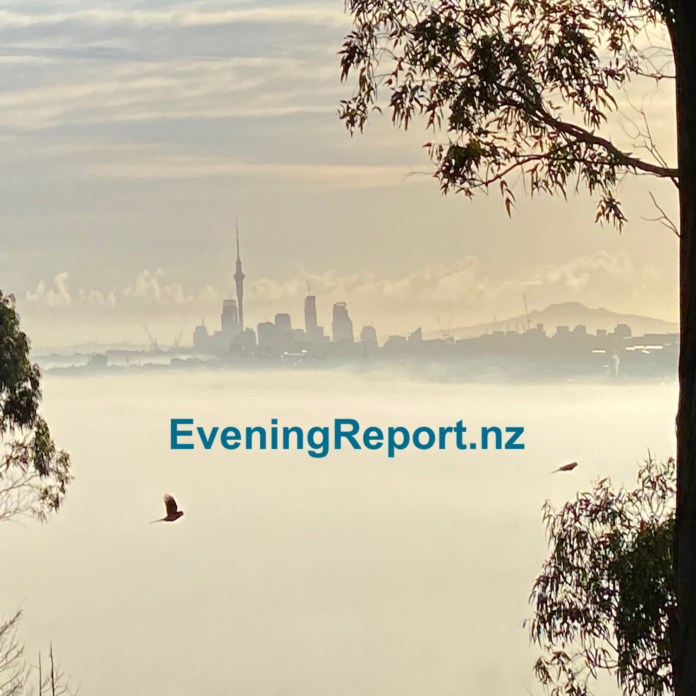Source: Radio New Zealand
The highly anticipated opening of Swedish furniture company IKEA in New Zealand comes as a rural community worries about the fire risk from pine plantations.
Since 2020 IKEA has converted six Central Hawke’s Bay farms into pine forestry, which they believe makes them the largest forestry owner in the district.
This move, combined with the sale of at least four other Hawke’s Bay farms to overseas forestry companies this year, is sparking concerns from locals about the loss of productive farmland and the risks associated with converting large areas into pines.

At least four other Hawke’s Bay farms have been sold to overseas forestry companies this year. Photo: RNZ / Alexa Cook
‘Dumbest thing NZ has done in agriculture’
To better understand the scale of this land-use change, Porangahau farmer James Hunter and pilot Joe Faram flew RNZ over thousands of hectares of new pine trees that now cover what had been traditional farmland for generations.
“This is the dumbest thing New Zealand has done in agriculture,” Hunter said.
He wants New Zealanders to witness the extent of farmland being planted in forestry.
“It’s not just one farm, it’s farm after farm and I think it’s the scale of it that people don’t understand.
“Suddenly we’ve got a district that’s been swallowed, and this is apparently good for the country,” he said.

A newly planted forestry block in Central Hawke’s Bay near Pourere, each sprayed circle is a pine tree. Photo: Nick Monro
- More than 1.8 million hectares of New Zealand is planted in pine trees with many farms having been converted since 2008 to earn carbon credits after the Emissions Trading Scheme was introduced.
- This resulted in more ‘carbon farming’ where forests are planted for carbon credits and permanently locked up rather than being harvested for timber.
- Swedish furniture company IKEA has bought 28,000 hectares of New Zealand farmland since 2021, with another 10,000 currently pending approval in Northland.
- However, IKEA told RNZ none of its trees have been planted for carbon credits, although they may look at ‘some form of offsetting in the future’.
- A recent report from the Climate Change Commission estimated another 900,000 hectares of land will be converted to forestry by 2050.
- Most of IKEA’s 4300 hectares of forestry in Central Hawke’s Bay is near the village of Porangahau, where about 200 hectares of its pine trees went up in flames in October and took days to extinguish because of the high winds grounding helicopters.
It’s fires like this that have rural communities on edge, because they say even if the blaze starts on nearby farmland, the forests contain the fuel that feeds them.
“So the question for the forestry owners is how confident are they that they can stop New Zealand haemorrhaging money chasing fires?” Hunter said.
“They’ve brought basically the equivalent of petrol tankers into these rural districts. Why should we pay for the cost of fighting something while they’re making extraordinary money?”

Porangahau farmer James Hunter took RNZ reporter Alexa Cook up in a helicopter to get a clearer view of the extent of pine plantings across the region. Photo: Nick Monro
Hunter believed there’d been ‘no thought to firefighting’, especially in high winds.
“I want to see them have to put in their own water supplies. And I want some confidence that they can fight a fire when the helicopters are not able to fly – and if the helicopters are not able to fly, what happens to the rest of us downwind?”
He’s concerned that Fire and Emergency New Zealand (FENZ) didn’t have the resources to deal with major blazes. FENZ said it’s primarily funded through the Fire and Emergency levy, which is collected on contracts of fire insurance. However, there is no mandatory requirement for foresters to insure.
“We do not have a separate breakdown of levy contributions from forestry companies,” a FENZ spokesperson said.
“Other than funding from the levy, Fire and Emergency does not receive any additional dedicated funding to fight forestry fires.”
The organisation said it was “confident in its ability to respond effectively to forestry fires”.

About 200 hectares of IKEA’s Central Hawke’s Bay forestry went up in flames in October. Photo: RNZ / Alexa Cook
IKEA’s forestland country manager Kelvin Meredith told RNZ the company, like many other forestry owners, did not have fire insurance.
“We don’t insure for fire. It’s prohibitively expensive in New Zealand,” he said.
The Forest Owners Association said about 30 to 40 percent of plantation forest estate was insured. It varied year to year as owners reviewed their risk management.
“Standing crop insurance is becoming increasingly unaffordable, so – like other rural landowners – forest owners weigh the cost, risk and benefits each year,” it said.
“Some companies choose to self-insure and invest heavily in their own firefighting capability, which in turn strengthens rural fire response more broadly.”
Meredith agreed that there is a lot of fuel in a forest but said it provided fire plans to FENZ and worked closely with it to mitigate the fire risk.
“What we can do is have decent fire breaks and decent fire plans in place so if it does break out, the key consideration is that no one’s life is in danger.
“I can’t speak for all forest owners, but I think we’re relatively well prepared in the event of a fire,” said Meredith.
Hunter said if forest owners weren’t contributing financially to FENZ, or properly mitigating the fire risk, then it’s unfair on farmers who did pay fire insurance levies and were investing in fire protections.
“So you want to go and plant your trees? Cool. Don’t leave me with the costs.”

Farmer James Hunter is worried forestry companies aren’t taking the fire risk seriously. Photo: Nick Monro
There’s also currently no mandatory requirement for forestry owners to reduce or mitigate fire risk, but the Forest Owners Association said $21 million a year was spent on fire protection.
Nationally, FENZ had 15 formal service-level agreements with major forestry companies that outlined resource sharing arrangements and joint responsibilities during wildfire events, and said three more were being finalised.
FENZ wouldn’t provide forestry fire plans to RNZ, but said there was ongoing investment in training and technology to ensure they remained well-prepared as fire risks evolved “due to climate and land-use changes”.
“Fire and Emergency remain committed to working with all stakeholders to protect people, property, and the environment from the growing threat of wildfires.”
IKEA said it would consider supporting calls for legislation requiring all landowners, from farmers to foresters, to mitigate fire risk and invest in fire protections.
“If it’s practical and effective and can be implemented in an effective manner. It’s no good writing a piece of legislation that only half the population is going to follow,” said Meredith.
‘I’m embarrassed to be a New Zealander’
Pilot Joe Faram has been fighting forestry fires for decades. He’s had a front row seat witnessing Hawke’s Bay’s landscape steadily change from farms to pines.
“The transition has been very vast over the last 15 years … a lot of that mindset has been detrimental to the betterment of New Zealand.
“I’m embarrassed to be a New Zealander, it’s shameful,” he said.

Pilot Joe Faram has been fighting fires from the air for decades and worries the risk is increasing. Photo: Nick Monro
As a pilot, he said there was a lot of pressure on aerial fire-fighting resources because it’s often the main tool for containing a forestry blaze.
He’s concerned the increase in pine trees is creating a bigger fire risk.
“Because there’s more material, there’s more fuel. We’re certainly putting ourselves in a dangerous situation, so you’re managing risk control.
“By a little bit of good fortune and luck, we have had fires, but we’ve managed to suppress them quite effectively. But one day, the Swiss cheese will line up and we will have a fire that, instead of putting it out in two or three days, it could be up to a month,” he said.
It’s a fear shared by Porangahau hapu Ngāti Kere. Chairperson David Tipene Leach has been in discussions with IKEA since 2022.
“They came to the marae, they talked to us, they told us what they had to offer.
“When you look back on it a couple of years later, actually there’s not much to offer.”

David Tipene Leach feels the spread of forestry in Hawke’s Bay is like another wave of colonisation for Ngāti Kere. Photo: Nick Monro
Since the fire in October, he’s written to IKEA on behalf of the hapu, urging it to remove the pine trees planted closest to the village in an area known as Stoneridge.
“If you look around the world, and certainly in this day and age, we look into Canada and into the States and other places, and you see the huge forest fires that are occurring in these big plantations, we’ve got to be worried about that sort of stuff.
“With regard to exit and entry from our little isolated town, they’re planting, planting all along the road. You can’t get out of our town if the forests are burning,” he said.
However, IKEA said it’s unlikely it would remove trees.
“As far as taking the whole Stoneridge face out of trees, I can’t see that happening. What we need to do is meet with the community and understand what are the real concerns here related to fire,” said Meredith.

An area of new pine plantings in Central Hawke’s Bay. Photo: Nick Monro
For Tipene Leach, there’s a sense of sadness around seeing farmland planted in pine.
“It’s kind of like this is just another, you know, I don’t want to sound silly, but another wave of colonisation that Ngāti Kere has to deal with.
“Us small hapu, we’re fighting for survival here. We’re not really fighting to change the world. We’re just fighting to maintain our little bit of the world.”
He worried the pine problems seen in Tai Rāwhiti with slash and community loss were creeping down the East Coast, and Hawke’s Bay was set to make the same mistakes.
“The forestry people will tell us, don’t worry, we’ve all learned since then.
“But they are commercial operators who are out there to make a buck where they can, and so I’m not sure that we have any reason to trust them,” Leach said.
Forest Owners Association chief executive Elizabeth Heeg said commercial foresters did want to make a return on their investments, but the returns were slow to be realised and forest owners were highly motivated to protect the environments and communities their trees grew in.
“Part of this is adapting to climate change and with increasing numbers of significant storms, foresters are very focused on adapting their forest and harvest management plans to prevent and prepare for incidents where forest waste leaves their land.
“Our forests are a vast resource and with greater collaboration across the industry and other sectors, using woody biomass for energy generation, more timber in construction, and increasing domestic processing, New Zealand has a significant opportunity to gain far greater value from them,” said Heeg.

Pine forestry in southern Hawke’s Bay Photo: Nick Monro
IKEA said while it couldn’t answer for all foresters, the company was “pouring cash into the country”.
“We’re planting forests … we’re buying native seedlings, we’re employing local contractors, employing planting crews … and we won’t realise a return for 28 years.
“We’re not extracting a lot of cash out of the country for the benefit of an offshore entity, that’s for sure,” said Meredith.
He said IKEA had put a “little bit of a pause” on buying farmland at the moment and was buying existing forests instead.
The timber grown in New Zealand would be used in IKEA’s furniture, however, it’d be shipped overseas for manufacturing.
“The sad situation we’re in is you can actually send logs to places like China and bring back products made in those countries cheaper than we can do it here.
“We’d love to manufacture here. We’d love to support local processing but it’s just the economics are tough.”
Government taking forestry fire risk ‘seriously’
Forestry Minister Todd McClay told RNZ the government took the risk of forest fires seriously and had strengthened its approach in recent years.
“There has been a wide package of work across prevention, readiness, and response. This includes updated guidance for landowners and councils, better coordination between the New Zealand Forest Service and Fire and Emergency New Zealand, and ongoing investment in research, risk mapping, and seasonal forecasting,” he said.

Forestry Minister Todd McClay. Photo: Nick Monro
When asked if the government was considering legislation changes so that it’s mandatory for all landowners to reduce or mitigate fire risk, the minister said they already have responsibility for managing their property against the risk of fire.
“It’s important to note that 98 percent of wildfires in New Zealand are caused by human activity and often spread into forests.
“It’s also important to note that under the Fire and Emergency New Zealand Act 2017, FENZ have the authority to require a landowner to create and clear a firebreak on their property if it believes this is needed to help control fires.”
He believed forestry owners were doing enough to reduce the risk of fires on their land.
“Large forestry companies often have their own firefighting teams, equipment, and water supplies. Getting full insurance against fire damage is difficult, so some forestry owners choose to self-insure or buy partial coverage.
“Ultimately, the financial risk of losing trees to fire sits with the forest owner,” McClay said.
*RNZ was taken up on the flight by farmer James Hunter to give a snapshot of the land use change in the area.

Forestry in Hawke’s Bay Photo: Nick Monro
Sign up for Ngā Pitopito Kōrero, a daily newsletter curated by our editors and delivered straight to your inbox every weekday.
– Published by EveningReport.nz and AsiaPacificReport.nz, see: MIL OSI in partnership with Radio New Zealand






















